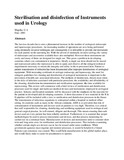Sterilisation and disinfection of Instruments used in Urology
Abstract
The last two decades have seen a phenomenal increase in the number of urological endoscopic and laparoscopic procedures. An increasing number of operations are now being performed using minimally invasive techniques and consequently it is infeasible to provide one instrument for each patient on the operating list. With the advent of minimally invasive urology the variety of endoscopes and accessories available have also multiplied. However these instruments are costly and many of them are designed for single use. This poses a problem in developing countries where cost containment is imperative. Ideally a single use item should not be reused and reprocessed unless the reprocessor is able to apply and observe all the stringent technical requirements necessary to ensure the integrity and safety in the re-processed item. Patient to patient transmission of infection has been documented after improper disinfections of urological equipment. With increasing workloads in urologic endoscopy and laparoscopy, the need for stringent guidelines for cleaning and disinfection of urological instruments is important in the prevention of health care associated infections. The methods of disinfection, chosen must relate to the risks of infection associated with particular procedure, the availability and affordability of the cleaning, disinfection decontamination and sterilization equipment, the time available for reprocessing. This review will commence with a brief review of sterilization and disinfection processes used for single and multi-use medical devices and instruments employed in urological practice. Industry and hospital standards will be discussed with the emphasis on the outcome for the patient in developed and developing countries. A short discussion of new material in the R & D pipeline will be included with a view to sterilization and disinfection processes in the future. The transmission of infectious organisms is widespread within a hospital or medical office setting. In countries such as many in the African continent, AIDS is so prevalent that risk of contamination of instruments and devices used on patients is very high. Therefore, it is critical that staff responsible for cleaning, disinfecting and sterilizing equipment used in urological and general surgical practise, be well-trained, diligent and thorough. This means ensuring that each device used on every patient has been reliably sterilized. Furthermore, it is essential that proper methodologies be used to process instruments and devices, and that process monitoring be carried out on a continual basis. Manufacturers of devices and instruments need to consider short term and long-term costs for sterilization and disinfection processors. This includes examining whether certain single use devices can in fact be reused under some conditions. While government agencies must regulate and monitor processes, it would be helpful if a United Nations type consensus was created. This would help manufacturers in the global market-place, and would likely make it easier for practitioners to operate.
URI
http://profiles.uonbi.ac.ke/gmagoha/publications/sterilisation-and-disinfection-instruments-used-urologyhttp://hdl.handle.net/11295/12300
Citation
WHO and IUCC Health Publication 2001; p. 121 - 150Publisher
IUCC Health College of Health Sciences

